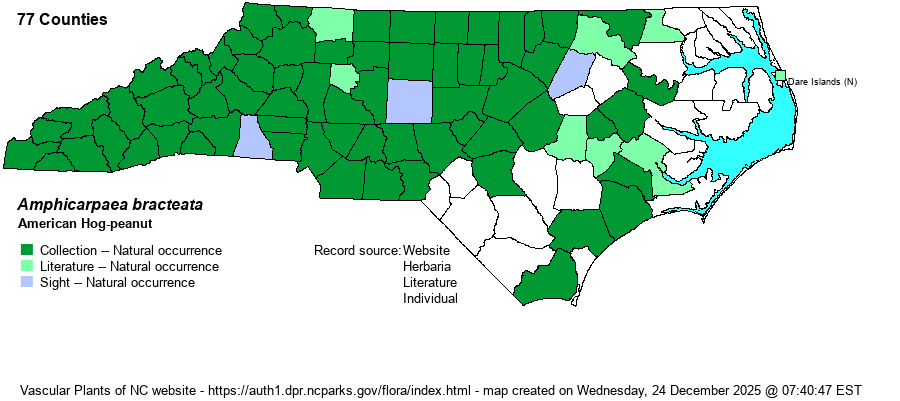| Author | (L.) Fernald | |
| Distribution | Throughout the Mountains and Piedmont, and sporadically eastward into the central and southern Coastal Plain. Absent from the Sandhills proper and from almost all of the eastern Coastal Plain, with no records east of Northampton, Martin, Pitt, Jones, and Onslow counties -- except for an iNaturalist photo (with flowers) from Kitty Hawk Woods on the Dare County Outer Banks, a plausible place for this species.
This is a very widespread species found across most counties from eastern Canada to northern FL and eastern TX. | |
| Abundance | Common and easily found throughout the Mountains and the Piedmont; mostly infrequent and local into the central and southern Coastal Plain, and absent in the Sandhills. Very rare to absent in the far eastern counties. | |
| Habitat | This is a species mainly of moist forests, damp thickets, and bottomland forests. It does grow well upslope into mesic and somewhat dry forests, but for the most part it is found in fairly rich sites, including edges of such forests, and along stream banks. |
| Phenology | Blooms from July to September, and fruits from August to October. | |
| Identification | This is an herbaceous vine, with a slender stem that twines up to 3-5 feet long or high. The leaves are alternate on the stem, with each of the 3 leaflets being ovate to nearly triangular, with strongly rounded bases and a tapered tip, each being about 1.5 inches long and 1 inch wide. The leaflets have hairs that are flattened to both the upper and lower leaf surfaces, a helpful identification key in separating this species from Thicket Bean (Phaseolus polystachios). The very slender stem with three somewhat triangular leaflets is normally sufficient to identify it, but if not, the dense cluster (raceme) of pale pink, lilac, or white flowers coming off the leaf axils should clinch the identification. Each flower is narrow and about 0.6-inch long, but the cluster of flowers is several inches long. Biologists are very familiar with this species, which seems to grow in most forested sites with a rich slope in the western 75% of the state. | |
| Taxonomic Comments | Some sources give the alternate spelling Amphicarpa bracteata. Weakley (2018) and some other references list varieties for it -- in this case the nominate Amphicarpaea bracteata var. bracteata and also A. bracteata var. comosa.
| |
| Other Common Name(s) | Hog-peanut is often used. Rarely used is Ground-bean. | |
| State Rank | S5 | |
| Global Rank | G5 | |
| State Status | | |
| US Status | | |
| USACE-agcp | FAC link |
| USACE-emp | FAC link |

